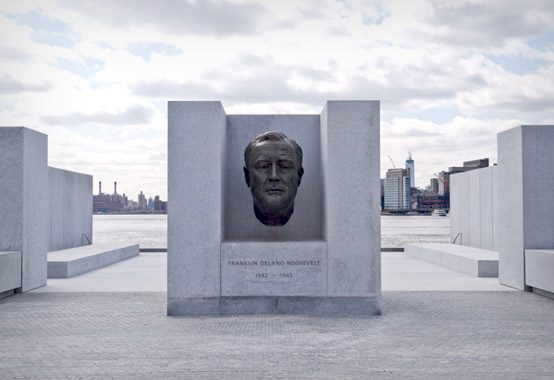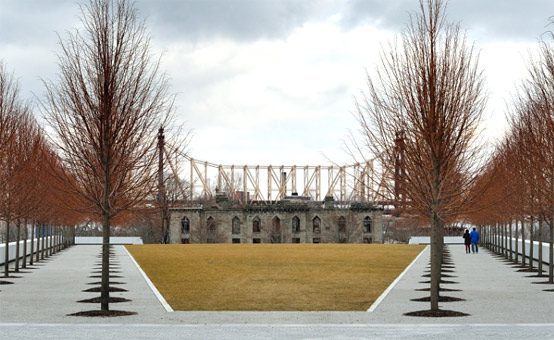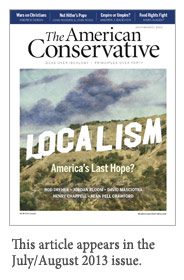Tomb of the Four Freedoms

Despite his recognition as one of the great modernists of the 20th century, postwar architect Louis Kahn claimed to be inspired by the crumbling edifices of the ancients. After trips to Italy, Greece, and Egypt, he developed his signature style: “I thought of the beauty of ruins … of things which nothing lives behind … and so I thought of wrapping ruins round buildings.” Fittingly for an architect influenced by the remains of temples and other sacred spaces, Kahn’s final commission was a public monument.
New York City’s Franklin D. Roosevelt Four Freedoms Park, designed by Kahn shortly before his death in 1974, finally opened last fall, four decades after it was first conceived and several generations after the 32nd president’s 1941 speech setting out the moral case for the coming war in terms of “freedom of speech,” “freedom of worship,” “freedom from want,” and “freedom from fear.” The Four Freedoms rhetoric would outlive Roosevelt and become a cornerstone of the American-led postwar international order, what was hoped to be a new era of perpetual peace and universal human rights.
The new tribute to this grand vision occupies a dramatic space at the southern tip of a narrow island in the East River between Manhattan and Queens. Around the same time the memorial was commissioned, the city renamed the 147 acres after FDR, and today Roosevelt Island is an increasingly upscale urban neighborhood, its thousands of residents connected to midtown Manhattan by an aerial tramway.
But it wasn’t always so idyllic. Before the FDR rebranding, it was known for decades as Welfare Island, a legacy of its history as the place where the city sent all its undesirables. From the early 19th century, the sick, insane, and destitute—and until the 1930s, most of the city’s convicts—were housed in this purgatory in the East River.
Most of the infrastructure of prisons and asylums has been demolished or repurposed, and today high-rises dominate the island. Yet one prominent reminder of the past, the 1856 Smallpox Hospital, sits abandoned and in advanced decay. Executed in the Gothic Revival style by James Renwick Jr.—who also designed St. Patrick’s Cathedral and the original Smithsonian Institution—it is a genuine ruin just steps from Kahn’s newly constructed one.
Given the island’s slender profile, under 800 feet wide in most places, a visitor en route to Four Freedoms Park cannot avoid encountering the former hospital, which officials plan to stabilize but leave in its current romantic condition. Dark stone walls, embattled parapets, and pointed-arch windows provide the illusion of medieval origin, and it is hard to imagine a more striking contrast to the FDR memorial and the new era it represents. The age of the charity hospital, imperfect but ornate, gives way to the abstract yet shining promise of the new world order and the welfare state, a place where diseases like smallpox are eradicated.
Approaching Kahn’s park—a series of outdoor spaces surrounded by bright white granite—one is nearly blinded. The entrance, a wide series of shallow steps, is set into a 12-foot slab that rises at an angle, like some ancient Aztec or Egyptian structure, and stands high enough to obscure what waits above and beyond.
Ascending this staircase suddenly reveals the memorial’s largest space, a triangular plaza. Sparingly landscaped, it features a lawn flanked by two symmetrical rows of linden trees, under which cobblestone paths meet at the same point several hundred feet away. The converging walkways are an impressive visual trick, making the space appear larger than it is.

Jerry Dohnal / creative commons
The clean lines first evoke a Parisian green, but the lack of furniture reminds one that despite its designation as a park, this is not a place for leisure. Indeed the memorial’s posted rules require that visitors leave picnics and pets at home in order to “preserve its sanctity.” The lawn space instead acts as the nave of a cathedral, a place that points to more hallowed precincts beyond.
At the terminus of both arboreal colonnades—the formal tone suggests walking on the grass is scorned—one is deposited in front of a Goliath-sized bust of FDR. Suspended in a large, recessed niche, it appears to float like the giant head in the Wizard of Oz.
But beyond this portrayal of Roosevelt as the Oracle of Hyde Park lies Kahn’s most dramatic feature. On either side of the small forecourt containing the bust, one enters a space that widens slightly to form an outdoor room, open to the sky but surrounded on three sides by 12-foot-high slabs of gleaming white granite. Upon crossing the threshold to this tomb-like space, one directly faces the fourth side, completely open to the river and the Manhattan skyline, prominently framing the United Nations complex.
Here anyone who has been to presidential memorials in Washington expects to see the words of the great man chiseled into the tablets for the ages. On one central panel the visitor is not disappointed. Ninety-seven words that form the key passage of the 1941 State of the Union address are faithfully reproduced, ensuring one doesn’t leave without actually encountering Roosevelt’s formulation of the Four Freedoms:
In the future days, which we seek to make secure, we look forward to a world founded upon four essential human freedoms. The first is freedom of speech and expression—everywhere in the world. The second is freedom of every person to worship God in his own way—everywhere in the world. The third is freedom from want … everywhere in the world. The fourth is freedom from fear … anywhere in the world. That is no vision of a distant millennium. It is a definite basis for a kind of world attainable in our own time and generation.
A score of additional slabs line the 60-foot-square space, all unadorned. The overall effect is more unsettling than inspiring—a feeling that the tabernacle is empty. Gazing a short distance across the water at Turtle Bay, the UN complex, perhaps the most lasting legacy of FDR’s vision, appears as a sad relic of another era, when the victorious Allies were confident that a permanent international order would rise from the ashes of World War II.
 In choosing Kahn, Roosevelt Island’s planners may have simply been deferring to a man considered one of the most cutting-edge architects of the 1970s. But their choice has inadvertently resulted in a monument that presents the Four Freedoms as a cold, technical formula. Both Kahn’s monument and FDR’s doctrine overemphasize form at the expense of narrative.
In choosing Kahn, Roosevelt Island’s planners may have simply been deferring to a man considered one of the most cutting-edge architects of the 1970s. But their choice has inadvertently resulted in a monument that presents the Four Freedoms as a cold, technical formula. Both Kahn’s monument and FDR’s doctrine overemphasize form at the expense of narrative.
Other attempts to canonize the Four Freedoms were more successful. Norman Rockwell’s series of paintings on them helped the U.S. Treasury raise $132 million in war bonds. Another monument commissioned by FDR himself used four angels to represent the freedoms—once revealed to great fanfare in Madison Square Garden, it now resides in obscurity in a small town in the Florida panhandle, hometown of an early war hero who died in combat at Pearl Harbor.
One of the most famous depictions of political freedom lies downstream from Roosevelt Island in New York Harbor. The Statue of Liberty provides an allegory that enables many potent narratives, including the celebrated lines from the sonnet inscribed at its base: “Give me your tired, your poor / Your huddled masses yearning to breathe free …” It is an image that endures because it tells a powerful story.
Whether the lack of similar energy in the new FDR memorial is due to the shortfalls of Kahn’s method or the eclipse of the Four Freedoms internationalist vision, the park is a missed opportunity—it was a place positioned to be an American analog to Paris’s Île de la Cité, the site of Notre Dame. But visitors to Roosevelt Island can instead take a page from the Victorians and picnic under the ruins of Renwick’s hospital, remembering a time when monuments drew on the full range of human passions, displaying those elusive qualities that lie between form and function but make all the difference.
Lewis McCrary is managing editor of The National Interest.
Comments